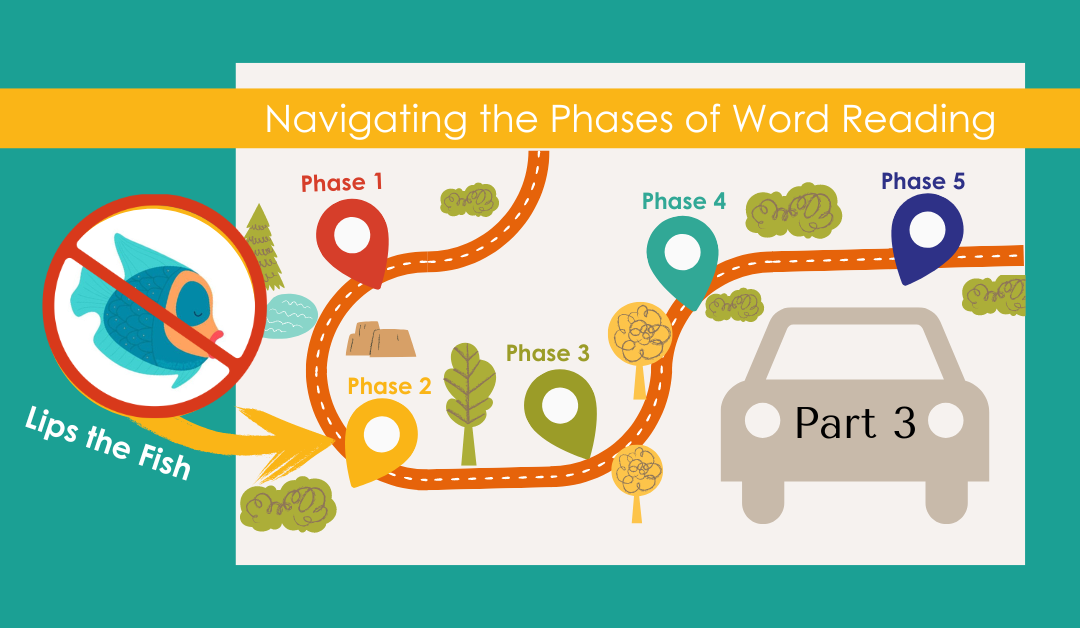This post is our third in a 6-part series about how you can support readers who are trying to read a word they don’t know. Deciding how to prompt readers when they are stuck or uncertain is one of the most nuanced and critical jobs of literacy educators, and its implications last long beyond a child’s current grade. So being really intentional about the ways we do (and don’t) scaffold readers at the point of difficulty–selecting the prompts that hold the most promise for helping them learn to navigate the alphabetic system proficiently–really matters.
In our first post of this series, we imagined young explorers learning to read a paper map–think back before Google Maps and Siri–as a metaphor to unpack Ehri’s Phases of Word Reading. In the metaphor, the map is the text, map-reading skills are knowledge of the alphabetic system, and the phases are explained as ways to navigate with less or more map-reading competency. Of course, the goal for our young navigators is to help them find their way through words (and even whole texts) with increasing ease and confidence.
Last week – starting with Eagle Eye, or “Look at the picture” – we used Ehri’s phases (1987, 1995, 2002, 2005, 2017) as a lens to revisit prompting practices we have routinely leaned on in the past. We explored why prompting students to “Look at the picture” is teaching them to, in that moment, read like a reader in the pre-alphabetic phase. Looking at the picture instead of the print is a way of navigating around a word, a behavior that we definitely don’t want to have students habituate. We also offered several reasons this practice is simply not as effective as we had once believed and that it can even prevent forward progress for some beginning readers.
But picture-prompting via a stuffed animal eagle isn’t the only worrisome–albeit cute, fun, and catchy–cue we need to reconsider if we want our young navigators to become proficient with our alphabetic system.
Today we turn our attention to the prompt, “Get your mouth ready,” and Lips the Fish, who is often used as the mascot for this call to action.
“Get your lips ready” is a cue to the reader to get their mouths in position to say the first sound in the word. In fact, the directions often include this more specific guidance, “Get your lips ready to say the first sound.” Kari was once even taught, “Once children say the first sound, the rest of the word will often just sort of fall out of their mouths.” This seems true and sufficient when students get the rest of the word after thinking about the first sound and the context. And they have little reason to even look at the rest of the word.
Of course, getting prepared to produce the phoneme represented by the first grapheme isn’t the wrong thing for readers to do. However, the prompt that launched the popularity of our friend Lips the Fish grew out of the prompt “Get your mouth ready,” which has a decided emphasis on the first letter (or two), without encouragement to keep moving across the word. What’s more, it was often followed up by, “What would make sense?” which was a suggestion to make a prediction about what the word might be by relying on the context in combination with the initial sound.
This never meant that children couldn’t use the rest of the letters in the words, but in many beginning texts, the context + first letter combination got the job done more easily than decoding all the way through the word. This ease seemed like a good deal for children and made us happy as teachers because we appreciated that it allowed children to feel successful faster. They pulled the pieces together to “read”–or more accurately to say–the word without the need to make all the graphophonemic connections within it.
If you revisit Ehri’s phases from earlier in this series, you can probably guess which phase of word reading this prompt directs children to replicate, can’t you?
If you said the Partial-Alphabetic Phase, then we agree. Unlike last week’s prompt, “Look at the picture,” which took children completely away from the print, “Get your lips ready” is clearly encouraging children to use part (a small part!) of the print–hence “Part”ial Alphabetic Phase.
Yet even though they are using a bit of print, what our prompting essentially says to them is, “Readers don’t need to look all the way across a word. They can use small bits of it and still figure things out.”
When we prompt children to navigate the word by revisiting or reverting to the partial-alphabetic phase, we are NOT teaching them to read and blend together all of the sound-spellings from left to right. We are not telling them the whole truth about reading, which is that ALL of the print matters. For this prompt, like the last, taking a detour from the letters on the page can take children down some rocky roads and delay their arrival at their destination.
What’s more, rerouting through context rather than reading through each sound in the word may seem faster, but it means precious time and opportunity for building orthographic knowledge is lost. And processing lots of orthography–giving the brain a chance to study lots of sound-spellings — is essential for moving through the full alphabetic phase. In fact, children won’t even reach the more proficient phases of consolidating and reading words automatically if they don’t spend substantial time building orthographic knowledge in the full-alphabetic phase. Basically, they need to do a lot of decoding in order to eventually read without needing to do a lot of decoding!
Over-reliance on the first sound-spelling simply reinforces more immature reading behaviors. And, just like Eagle Eye, our fishy friend can also lead children down a path that contributes to the eventual need for intervention and the undoing of habits that won’t hold up down the road.
So even though encouraging children to get their lips ready with Lips the Fish may seem like a fun and fast fix for figuring out some words, it’s a hard trade-off in the long run.
By now, we hope you are seeing the profound connections between how we prompt and how children learn to navigate text.
Next time, Skippy the Frog is on deck as we consider the pitfalls of advising young readers to ”Skip over it” when it comes to reading a tricky word.
Until then, we send you off with much love! (But less fish lips!)
❤️ Jan and Kari
P.S. Wondering what to teach instead of “Get your mouth ready”?
You guessed it!
Use a prompt that directs children to use the print, drawing on all they know about sound-spellings. Here are some of our favorites:
- “Sound it out.”
- “Look all the way across the word. Make the sounds.”
- “Keep your eyes on the word. Put the sounds together.”
Then, only after students have used all of the print–sound-by-sound from left to right–to come up with what they think is the word, do we follow up with prompts like, “Did that make sense?” or “Does that sound right?” This keeps decoding as the strategy of first resort, and context and meaning as ways to confirm decoding attempts.
If you want to learn more about this important topic, it is the primary focus of Shift 5 in our book – Shifting the Balance: 6 Ways to Bring the Science of Reading into the Balanced Literacy Classroom – and in our online class.
References
Ehri, Linnea C. 1995. “Phases of Development in Learning to Read Words by Sight.” Journal of Research in Reading Research 18 (2): 116-125.
Ehri, Linnea C. 2005a. “Learning to Read Words: Theory, Findings, and Issues.” Scientific Studies of Reading, 9 (2): 167–188. doi: 10.1207/s1532799xssr0902_4
Ehri, Linnea C. 2005b. “Development of Sight Word Reading: Phases and Findings.” In M. J. Snowling and C. Hume (Eds.), The Science of Reading: A Handbook (pp. 135–154). Oxford, UK: Blackwell.
Ehri, Linnea C. 2017. “Orthographic Mapping and Literacy Development Revisited.” In Theories of Reading Development, ed. K. Cain, D. L. Compton, and R. K. Parrila (pp. 169-190). Amsterdam, The Netherlands: John Bejamins, doi: 10.1075/swll.15.08ehr.
Explore the whole blog series:
Showing Young Readers How to Navigate the Phases of Word Reading
Part 1: A Journey Through Ehri’s Phases
Part 2: Why Looking at the Pictures Isn’t as Helpful as We Thought
Part 3: Why Looking at the First Letter of the Word Isn’t Enough
Part 4: Problems With Skipping Words
Part 5: The Downsides of Asking Children to Search for Chunks in Words
Part 6: The Power of Teaching Students to Blend Words
BONUS: The Power of Teaching Readers to Try Alternate Sounds



Recent Comments